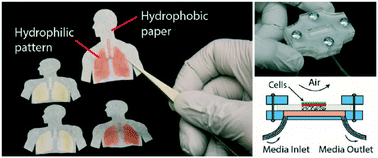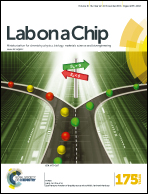A paper-based in vitro model for on-chip investigation of the human respiratory system†
Abstract
Culturing cells at the air–liquid interface (ALI) is essential for creating functional in vitro models of lung tissues. We present the use of direct-patterned laser-treated hydrophobic paper as an effective semi-permeable membrane, ideal for ALI cell culture. The surface properties of the paper are modified through a selective CO2 laser-assisted treatment to create a unique porous substrate with hydrophilic regions that regulate fluid diffusion and cell attachment. To select the appropriate model, four promising hydrophobic films were compared with each other in terms of gas permeability and long-term strength in an aqueous environment (wet-strength). Among the investigated substrates, parchment paper showed the fastest rate of oxygen permeability (3 times more than conventional transwell cell culture membranes), with the least variation in its dry and wet tensile strengths (124 MPa and 58 MPa, remaining unchanged after 7 days of submersion in PBS).The final paper-based platform provides an ideal, robust, and inexpensive device for generating monolayers of lung epithelial cells on-chip in a high-throughput fashion for disease modelling and in vitro drug testing.



 Please wait while we load your content...
Please wait while we load your content...